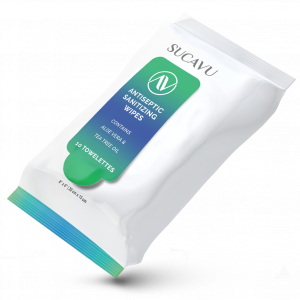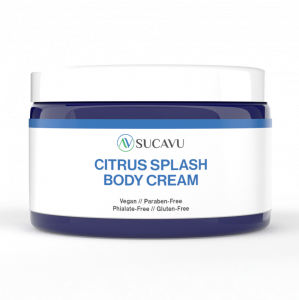SUCAVU Phyto-Cannabinoid CBD Manufacturer, Announces Benefits to Dirt-to-Door Inspected™ Validation Process in OREM UT
SUCAVU’s “Real Spectrum, Real Cannabinoids” Approach to CBD Product Development Earns a “BEST OF UTAH Skin Care” & “Best of Utah Nutritional” Brand Recognition
We uniquely provide the highest quality CBD products on the market because of our renown Dirt to Door-Inspected™ Manufacturing Process.”
OREM, UTAH, UNITED STATES, April 4, 2022 /EINPresswire.com/ -- CBD, or cannabidiol, is the second most prevalent active ingredient in cannabis (marijuana). While CBD is an essential component of medical marijuana, it is derived directly from the hemp plant, a cousin of marijuana, or manufactured in a laboratory. One of hundreds of components in marijuana, CBD does not cause a "high" by itself. According to a report from the World Health Organization, "In humans, CBD exhibits no effects indicative of any abuse or dependence potential…. To date, there is no evidence of public health related problems associated with the use of pure CBD."— Deshelle Gray, Founder
Picked Peak Potency™ …The SUCAVU farm system guarantees that all of their plants are harvested when the desired cannabinoid is at its peak potency. They are then extracted and bottled with each product containing a 95% bioequivalence standard for increased cannabinoid uniformity, potency and effectiveness. IG: @sucavucbd
Why SUCAVU? Dirt-to-Door Inspected™ … SUCAVU cannabinoids are grown on farms that are controlled and monitored by SUCAVU. From the soil, to harvest and through extraction, SUCAVU provides tracking-and-analysis through the entire process and finalizes the procedure with the certificate of analysis (COA) on the product. Excellence is a requirement. SUCAVU does not settle. Find Cannabidiods @: shop.sucavu.com/sucavucorporate/Products
CBD
Cannabidiol (CBD) grew from a fad into a major industry unto itself, with one recent estimate predicting that CBD sales in the U.S. could reach $1.8 billion by 2022. Its available in large amounts in both marijuana and hemp, and thus easily cultivated, and health claims associated with it include ease of anxiety and movement disorders, and even physical pain when applied topically. CBD is sold as tinctures, edibles, vaporizer oils, and in ointments. One can still smoke it, too; The company Canna-flower, for one, offers an assortment of high-quality CBD-rich hemp flowers that could easily be mistaken for top-shelf marijuana. More than that, though, businesses have tried adding it to practically every product imaginable: Sandwiches, ice cream, coffee, candles and even clothing have been sold containing CBD. Given its reputation for providing relaxation without any intoxicating effects, the cannabinoid has also become a popular option for nervous dogs who are frightened by thunder and fireworks.
CBG
Since canna-bigerol is the parent molecule from which all other cannabis compounds are synthesized—meaning THC, CBD, etc., all start as CBG—it is often called the "mother" of cannabinoids. The exact laws that apply to its sale are murky, though companies generally adhere to the same rules applied to CBD when selling it (and all the cannabinoid supplements on this list, other than THC). Being hard to extract means many companies haven't invested in producing and selling CBG, but its promise has proven alluring enough for some to begin adding it to their lines. As the "mother," CBG could be more powerful, or at least offer a more comprehensive range of benefits, than other cannabinoids. At the very least, manufacturers believe it has creates a powerful "entourage effect" when combined with CBD. This effect refers to cannabinoids working in conjunction with one another—be it THC and CBD, CBD and CBN, etc.—and enhancing the individual properties of each.
CBN
Cannabinol is another mildly psychoactive, non-intoxicating cannabinoid only available in trace amounts in cannabis. However, it also forms when cannabis ages with THC breaking down into CBN. This then makes it easier for sellers to make, and some early studies suggest CBN may be a potent antibacterial agent. Another study in lab mice shows it could be effective in slowing the effects of Lou Gehrig's disease and other neurodegenerative conditions. Thus far, though, CBN has earned quite a reputation as a natural sedative.
Supreme Products Are Our First Priority: SUCAVU products will truly provide a broad range of benefits that simply cannot, and will not, be found anywhere else. Capable of allowing anyone to feel relaxed, refreshed and re-energized from the inside out, SUCAVU’s impressive line of cannibidiol based products will bring improvements – from renewed skin health and youthfulness to your overall well-being. .instagram.com/sucavucbd/
What are Cannabinoids? The word cannabinoid refers to every chemical substance, regardless of structure or origin that attaches to the cannabinoid receptors of the body and brain called your Endo-Cannabinoid System.
What is the Endo-Cannabinoid System? The endocannabinoid system (ECS) is a complex cell-signaling system identified in the early 1990s by researchers exploring THC, a well-known cannabinoid. Cannabinoids are compounds found in cannabis. Experts are still trying to fully understand the ECS. But so far, we know it plays role in regulating a range of functions and processes, including: Sleep, Mood, Appetite, Memory, Reproduction and Fertility. The ECS exists and is active in your body even if one doesn’t use cannabis. Read on to learn more about the ECS including how it works and interacts with cannabis.
The ECS comprises a vast network of chemical signals and cellular receptors that are densely packed throughout our brains and bodies. The "cannabinoid" receptors in the brain — the CB1 receptors — outnumber many of the other receptor types on the brain. They act like traffic cops to control the levels and activity of most of the other neurotransmitters. This is how they regulate things: by immediate feedback, turning up or down the activity of whichever system needs to be adjusted, whether that is hunger, temperature, or alertness. To stimulate these receptors, our bodies produce molecules called endocannabinoids, which have a structural similarity to molecules in the cannabis plant. The first endocannabinoid that was discovered was named anandamide after the Sanskrit word ‘ananda’ for bliss. All of us have tiny cannabis-like molecules floating around in our brains. The cannabis plant, which humans have been using for about 5,000 years, essentially works its effect by hijacking this ancient cellular machinery.
How does THC interact with the ECS? Tetrahydrocannabinol (THC) is one of the main cannabinoids found in cannabis. It’s the compound that gets you “high.” Once in your body, THC interacts with your ECS by binding to receptors, just like endocannabinoids. It’s powerful partly because it can bind to both CB1 and CB2 receptors. This allows it to have a range of effects on your body and mind, some more desirable than others. For example, THC may help to reduce pain and stimulate your appetite. But it can also cause paranoia and anxiety in some cases. Experts are currently looking into ways to produce synthetic THC cannabinoids that interact with the ECS in only beneficial ways.
How does CBD interact with the ECS? The other major cannabinoid found in cannabis is cannabidiol (CBD). Unlike THC, CBD doesn’t make you “high” and typically doesn’t cause any negative effects. Experts aren’t completely sure how CBD interacts with the ECS. But they do know that it doesn’t bind to CB1 or CB2 receptors the way THC does. Instead, many believe it works by preventing endocannabinoids from being broken down. This allows them to have more of an effect on your body. Others believe that CBD binds to a receptor that hasn’t been discovered yet. While the details of how it works are still under debate, research suggests that CBD can help with pain, nausea, and other symptoms associated with multiple conditions.
The bottom line: The ECS plays a big role in keeping your internal processes stable. But there’s still a lot we don’t know about it. As experts develop a better understanding of the ECS, it could eventually hold the key to treating several conditions.
The endocannabinoid system (ECS) is a widespread neuro-modulatory system that plays important roles in central nervous system (CNS) development, synaptic plasticity, and the response to endogenous and environmental insults. The ECS is comprised of cannabinoid receptors, endogenous cannabinoids (endocannabinoids), and the enzymes responsible for the synthesis and degradation of the endocannabinoids. The most abundant cannabinoid receptor is the CB1 cannabinoid receptors; however CB2 cannabinoid receptors, transient receptor potential (TRP) channels, and peroxisome proliferator activated receptors (PPAR’s) are also engaged by some cannabinoids. Exogenous cannabinoids, such as tetrahydrocannabinol, produce their biological effects through their interactions with cannabinoid receptors. 2-arachidonoyl glycerol (2-AG) and arachidonoyl ethanolamide (anandamide) are the best-studied endogenous cannabinoids. Despite similarities in chemical structure, 2-AG and anandamide are synthesized and degraded by distinct enzymatic pathways, which impart fundamentally different physiological and pathophysiological roles to these two endocannabinoids.
Because of the pervasive social use of cannabis and the involvement of endocannabinoids in a multitude of biological processes, much has been learned about the physiological and pathophysiological roles of the ECS. This review will provide an introduction to the ECS with an emphasis on its role in synaptic plasticity and how the ECS is perturbed in schizophrenia.
The endocannabinoid system (ECS) has emerged as an important neuromodulatory system over the last twenty-five years. Relevant to the topic of this special issue of Biological Psychiatry, perturbations of the ECS are involved in several psychiatric disorders, including schizophrenia. The ECS is comprised of endogenous cannabinoids (endocannabinoids), cannabinoid receptors, and the enzymes responsible for the synthesis and degradation of endocannabinoids. Each of these components will be introduced in this chapter, with an emphasis on their potential involvement in psychosis.
What do Cannabinoids do? SUCAVU Phyto Cannabinoids intersect with the Endocannabinoid System, whose primary function is to create balance and homeostasis. In research studies, this system has been referred to as the “Master Regulator” for every organ & system in the human body. Many of us have heard of some of the transmitter systems within our bodies, such as the sympathetic nervous system, which gives us our fight-or-flight response. Fewer have heard of the more recently discovered endocannabinoid system (ECS), which is amazing when one considers that the ECS is critical for almost every aspect of our moment-to-moment functioning. The ECS regulates and controls many of our most critical bodily functions such as learning and memory, emotional processing, sleep, temperature control, pain control, inflammatory and immune responses, and eating. The ECS is currently at the center of renewed international research and drug development.
Adam Green
G3 Development
+1 801-809-7766
g3president@comcast.net





